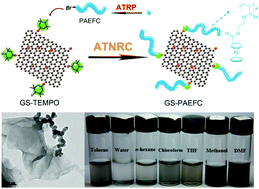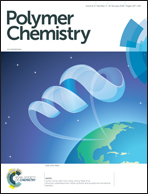Preparation of graphene/poly(2-acryloxyethyl ferrocenecarboxylate) nanocomposite via a “grafting-onto” strategy
Abstract
Graphene is of great significance for applications of fabricating new functional materials, due to its unique physical and chemical structure and properties. Modification of graphene with different polymeric chains has been widely investigated by a range of synthetic methods to extend its application. An efficient way to prepare 2,2,6,6-tetramethylpiperidine-1-oxyl-functionalized graphene sheets (GS-TEMPO), which can be used as grafting sites, has been reported by our group. Herein, Br-terminated poly(2-acryloxyethyl ferrocenecarboxylate) (PAEFC) homopolymers prepared by atom transfer radical polymerization (ATRP) were selected as the grafted brushes to be anchored on the surface of GS-TEMPO via atom transfer nitroxide radical coupling (ATNRC) chemistry for construction of functional electrochemical platforms. The product of the grafting reaction, graphene-PAEFC (GS-PAEFC) nanocomposite, was characterized by 1H-NMR, FT-IR, XPS, TGA, DTG, TEM and AFM. Cyclic voltammetry (CV) measurements show that the redox responsiveness of PAEFC is retained after surface functionalization. Moreover, GS-PAEFC nanohybrids are dispersible and stable in a wider range of organic solvents than the graphene oxide precursor nanosheets, paving the way for the development of smart nanocomposites.



 Please wait while we load your content...
Please wait while we load your content...